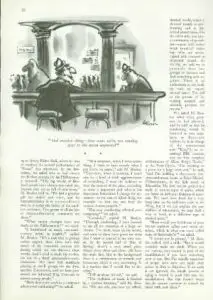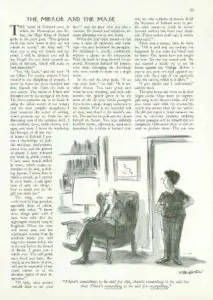 In Jorge Luis Borges’ “The Mirror And The Mask”, a court poet is asked by the High King of Ireland to create an ode to immortalize their victory against the Norwegians. Moving through the short story, we can begin to see a sort of evolution surrounding the ode as it appears to transform from what is perceived as a skillfully crafted literary masterpiece, to something much more silent and solemn.
In Jorge Luis Borges’ “The Mirror And The Mask”, a court poet is asked by the High King of Ireland to create an ode to immortalize their victory against the Norwegians. Moving through the short story, we can begin to see a sort of evolution surrounding the ode as it appears to transform from what is perceived as a skillfully crafted literary masterpiece, to something much more silent and solemn.
 In analyzing this evolution, we’ll be assisted by Paul Gee’s article, “What is Literacy? As well as a few points here and there from Trish Kelly’s lecture, “Memorial”. The first thing we must understand is that the ode is supposed to serve very obviously as a kind of memorial, “something that serves as a focus for memory” (Kelly 23 Sept. 2014); the poem serves to commemorate the Irishmen’s victory over the Norwegians as it gets presented each year on the battle’s anniversary. Secondly, the poems themselves are never revealed to us, leaving much to interpretation.
In analyzing this evolution, we’ll be assisted by Paul Gee’s article, “What is Literacy? As well as a few points here and there from Trish Kelly’s lecture, “Memorial”. The first thing we must understand is that the ode is supposed to serve very obviously as a kind of memorial, “something that serves as a focus for memory” (Kelly 23 Sept. 2014); the poem serves to commemorate the Irishmen’s victory over the Norwegians as it gets presented each year on the battle’s anniversary. Secondly, the poems themselves are never revealed to us, leaving much to interpretation.
With this understanding we can recognize two things: one, that the story seems to trace the ode’s evolution into a true memorial, and two, that each of the poet’s rewards can be seen as a symbol of the nature of the ode it’s rewarding. The poet’s first reward was that of a mirror. The main point of a mirror is, of course, for someone to take look at a reflection of their own face, and the first poem he wrote was very reflective of his own skill. The poet essentially created what was a representation of himself and his abilities in the attempt to capture the glory of the battle; the poem was the poet’s mirror.
To help us understand this, we must take a quick look at the meaning of discourse, an element of literacy. Discourse, as Gee describes, is as follows: “A socially accepted association among ways of using language, of thinking, and of acting that can be used to identify oneself as a member of a socially meaningful group or “social network. “‘” (Gee 537) This is important as it helps us understand that the poet is identified as “socially meaningful” in his linguistic abilities through his position as a poet.
Thus, the first poem can very much be viewed as his way of conveying that importance. The High King himself describes the poet in the first ode as having “skillfully handled rhyme, alliteration, assonance, quantities, the artifices of learned rhetoric, the wise variation of meters” (Jorges, 77), all aspects we would consider to be very technical elements of language. With the second poem, we can recognize how everything begins to deviate as the poet gets rewarded with a mask. What do we feel when we see a stranger in a mask? Curiosity, perhaps.
Discomfort from being denied a face to distinguish. With the second poem. the poet read it rather than recited it, and rather than describe the battle and glorifying the details, the poem itself “was the battle” (Borges 77). The poem was being transformed, from a “classic ode” (Borges 77) to “the battle” (Borges 77) itself, and that unfamiliar form seemed to cause the poet himself discomfort, but wonderment for his listeners. The poet felt the discomfort of unfamiliarity, and the court felt the intrigue of mystery; the same feelings inspired by a mask.
Furthermore, by understanding acquired and learned knowledge, both ideas of literacy, we see more clearly how the second poem represents the middle of this strange evolution, and how, as we move on to it, the final poem deviates from literacy altogether to embody a true memorial. “Acquisition is a process of acquiring something subconsciously by exposure [… ] [whilst] learning is a process that involves conscious knowledge gained through teaching” (Gee 539).
Though these definitions themselves do not help us in defining the odes, it does help us recognize the fact that by the second poem, the poet already begins to deviate from what defines literacy. Literacy, as we can see, comes from exposure and conscious gain. Therefore, what separates the final poem from the first two is the fact that it does not appear to have come from any knowledge that the poet had, but rather “The just] woke up speaking words [he] did not at first understand” (Borges, 79).
From this, it’s plain to see that the poem did not come from either exposure or conscious gain, and thus elevates it bevond to be something much more spiritual than technical. Another reason as to why we can view the final ode as a “true memorial” can be drawn from an example from Ancient Egypt in Trish Kelly’s lecture. The right to be remembered in Ancient Egypt was very exclusive, and architects were often even killed to protect the memorials of those with that right (Kelly 23 Sept. 2014).
This parallels with the final gift of the dagger and the poet’s suicide, and how, upon hearing the final poem, the King spoke of it as a “sin of having known Beauty, which is a gift forbidden to men” (Jorges, 79), and emphasized the need to keep the words a secret. Recalling how the rewards appear to reflect the respective natures of the poems, the message of death and sworn silence is made all the more obvious in the dagger. However, as we do have to remember the words of the poems are hidden from us as the readers, we can only speculate the specificities.
From these aspects, it’s clear to see that there is an obvious evolution across the three times the ode is written. What was a work of triumph and defined technical excellence grew to become something much more mysterious, formless, and spiritual—it became something that held power and required protection. Though the true meaning behind this evolution we may never know, the change in which the poem underwent helps us recognize what we consider remembrance, and reminds us of the mortality that lies behind the glory.